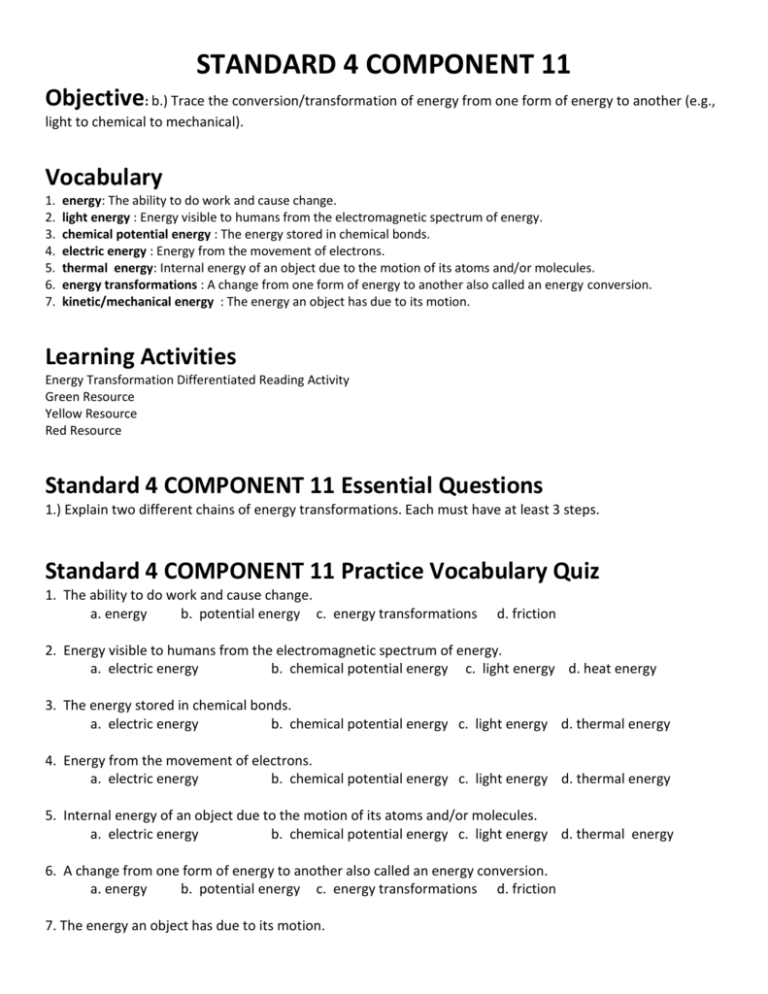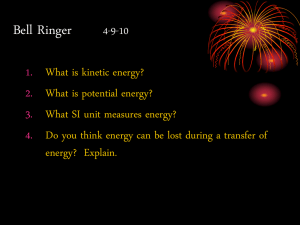STANDARD 4 COMPONENT 11 Objective: b.) Trace the conversion
advertisement

STANDARD 4 COMPONENT 11 Objective: b.) Trace the conversion/transformation of energy from one form of energy to another (e.g., light to chemical to mechanical). Vocabulary 1. 2. 3. 4. 5. 6. 7. energy: The ability to do work and cause change. light energy : Energy visible to humans from the electromagnetic spectrum of energy. chemical potential energy : The energy stored in chemical bonds. electric energy : Energy from the movement of electrons. thermal energy: Internal energy of an object due to the motion of its atoms and/or molecules. energy transformations : A change from one form of energy to another also called an energy conversion. kinetic/mechanical energy : The energy an object has due to its motion. Learning Activities Energy Transformation Differentiated Reading Activity Green Resource Yellow Resource Red Resource Standard 4 COMPONENT 11 Essential Questions 1.) Explain two different chains of energy transformations. Each must have at least 3 steps. Standard 4 COMPONENT 11 Practice Vocabulary Quiz 1. The ability to do work and cause change. a. energy b. potential energy c. energy transformations d. friction 2. Energy visible to humans from the electromagnetic spectrum of energy. a. electric energy b. chemical potential energy c. light energy d. heat energy 3. The energy stored in chemical bonds. a. electric energy b. chemical potential energy c. light energy d. thermal energy 4. Energy from the movement of electrons. a. electric energy b. chemical potential energy c. light energy d. thermal energy 5. Internal energy of an object due to the motion of its atoms and/or molecules. a. electric energy b. chemical potential energy c. light energy d. thermal energy 6. A change from one form of energy to another also called an energy conversion. a. energy b. potential energy c. energy transformations d. friction 7. The energy an object has due to its motion. a. electric energy b. chemical potential energy c. kinetic/mechanical energy Standard 4 COMPONENT 11 Practice Content Quiz 1. What type of energy conversion is taking place inside a flashlight when it is on? A. B. C. D. mechanical energy to light energy chemical energy to light energy chemical energy to mechanical energy electromagnetic energy to chemical energy 2. What type of energy conversion occurs when logs burn in a campfire? A. B. C. D. mechanical energy to nuclear energy heat energy to mechanical energy chemical energy to heat energy electrical energy to chemical energy d. thermal energy A dam backs up water so that the water level gets higher and higher. As a result the water stores more and more energy that can be used as it flows through a turbine which turns a generator inside the dam powerhouse. As the generator spins from the moving water it creates electricity that can be sent through long distance power lines to homes. Once the electricity gets to the home it can be converted or transformed into many other forms of energy. 3. As backed up water flows through the intake and into the penstock an energy transformation occurs. Which best describes this transformation? a. electrical to heat c. kinetic to electrical b. gravitational potential to kinetic d. potential kinetic to electrical 4. What best describes energy as it was described in this learning module? a. energy is always in the same form b. energy can be completely destroyed c. energy can only be changed from one form to another d. energy can be created Standard 4 COMPONENT 11 Essential Questions Key 1.) Explain two different chains of energy transformations. Each must have at least 3 steps. Sunlight getting changed into plant material (chemical potential energy) then being eaten by a rabbit and turned into muscle tissue (chemical potential energy), the rabbit being eaten by a fox and converted into body temperature of the fox (heat) and allowing the fox to run (kinetic energy). Water stored behind a dam has potential energy. The water starts to fall down a flume, which is kinetic, and turns a turbine. The turning turbine is also kinetic. The turbine generates electrical energy which is then transmitted to home via a wire. This allows a light to be turned on and this would be light energy. Standard 4 COMPONENT 11 Practice Vocabulary Quiz Key 1. The ability to do work and cause change. a. energy b. potential energy c. energy transformations d. friction 2. Energy visible to humans from the electromagnetic spectrum of energy. a. electric energy b. chemical potential energy c. light energy d. heat energy 3. The energy stored in chemical bonds. a. electric energy b. chemical potential energy c. light energy d. thermal energy 4. Energy from the movement of electrons. a. electric energy b. chemical potential energy c. light energy d. thermal energy 5. Internal energy of an object due to the motion of its atoms and/or molecules. a. electric energy b. chemical potential energy c. light energy d. thermal energy 6. A change from one form of energy to another also called an energy conversion. a. energy b. potential energy c. energy transformations d. friction 7. The energy an object has due to its motion. a. electric energy b. chemical potential energy c. kinetic/mechanical energy d. thermal energy Standard 4 COMPONENT 11 Practice Content Quiz Key 1. What type of energy conversion is taking place inside a flashlight when it is on? A. B. C. D. mechanical energy to light energy chemical energy to light energy chemical energy to mechanical energy electromagnetic energy to chemical energy 2. What type of energy conversion occurs when logs burn in a campfire? A. B. C. D. mechanical energy to nuclear energy heat energy to mechanical energy chemical energy to heat energy electrical energy to chemical energy A dam backs up water so that the water level gets higher and higher. As a result the water stores more and more energy that can be used as it flows through a turbine which turns a generator inside the dam powerhouse. As the generator spins from the moving water it creates electricity that can be sent through long distance power lines to homes. Once the electricity gets to the home it can be converted or transformed into many other forms of energy. 3. As backed up water flows through the intake and into the penstock an energy transformation occurs. Which best describes this transformation? a. electrical to heat b. gravitational potential to kinetic c. kinetic to electrical d. potential kinetic to electrical 4. What best describes energy as it was described in this learning module? a. energy is always in the same form b. energy can be completely destroyed c. energy can only be changed from one form to another from nothing d. energy can be created





